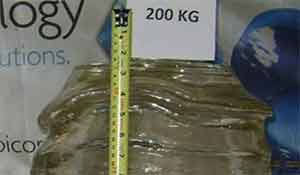Why is Sapphire Used in LEDs?
Sapphire is a chemically resistant material that is commonly used in LEDs. The main reason for using sapphire in LEDs is its ability to reflect light. As a result, manufacturers can produce patterned substrates. They begin with a blank sapphire and then etch it to produce a pattern. This process is commonly called plasma dry etching. The disadvantages of this technique include low etch rates and poor etched mask selectivity.
Since sapphire is transparent, LED makers can deposit gallium nitride onto the wafers. This process helps LEDs generate light from multiple surfaces. This is unlike packaged LEDs, which only emit light from a single surface. The packaging of an LED allows the light to be collected from the top surface, which makes it difficult to see. Because sapphire is transparent, it is the best material to use as a substrate for LEDs.
helps LEDs generate light from multiple surfaces. This is unlike packaged LEDs, which only emit light from a single surface. The packaging of an LED allows the light to be collected from the top surface, which makes it difficult to see. Because sapphire is transparent, it is the best material to use as a substrate for LEDs.
The main advantages of sapphire are its cost and industry expertise. It is also inexpensive, which makes it the most cost-effective material for making LEDs. It also allows manufacturers to produce inexpensive LEDs. But sapphire has its drawbacks. Compared to silicon, it has a thermal mismatch, lattice mismatch, and poor electrical conductivity. For these reasons, it is best not to use sapphire in LEDs.
Another disadvantage is its incompatibility. As silicon has failed to replace sapphire as a substrate, the manufacturers use silicon instead. In addition, they tend to use cheaper materials such as glass or plastic, which is not compatible with LED production. A lot of LEDs are produced using silicon, so sapphire is the least expensive. These factors, however, are just as important as the advantages.
Sapphire is also better than other substrates for LEDs. The reason for this is because it has a higher optical transmission rate than silicon. As a result, LEDs can have a much higher light output. This is a major advantage of sapphire over silicon. The downside of silicon is its low cost. But this is also a drawback of sapphire. The material is not suited for LEDs due to the high price and high temperature of the production process.
LEDs are the most popular applications for sapphire. The material is transparent and is an excellent conductor of light. In comparison, silicon is opaque and does not allow for efficient light extraction. The semiconductor material is ideal for LEDs, however, because it is both cheap and transparent. This makes it a great choice for LEDs. But a sapphire substrate has a low cost, making it a popular choice for this technology.
According to IHS Technology, sapphire is the most popular substrate material. It is cheap and readily available. Its high-quality properties make it the ideal substrate material for LEDs. Its low cost is an advantage, but it comes with disadvantages. For example, it has high electrical resistance. So it is not the best substrate material for LEDs. But it has its advantages. The downside is that it is not as durable as silicon.
While silicon has been the dominant sapphire application, the use of sapphire is becoming more prevalent. Its advantages over other semiconductor materials include its cost and availability of silicon. The cost of sapphire has made it the best choice for LEDs, and it is a common material in LEDs. The main advantage of sapphire is that it is inexpensive. This is the most attractive feature of sapphire.
Besides being cheap, sapphire also has advantages in terms of transparency. The high transparency of sapphire makes it an excellent material for LEDs. Its low cost makes LEDs cheap to produce. It is a great material for light-emitting diodes. While it may be more expensive, it is an excellent material for LEDs. There are disadvantages to sapphire though, including its lattice mismatch, thermal incompatibility, and electrical conductivity.
For example, patterned sapphire substrates can improve light extraction efficiency. The polygonal pyramid shapes of these substrates help enhance light extraction. It is also more durable than plain sapphire. The commercial Prism LED is a better option. The faceted pattern is more expensive, but is better for the LED. It also requires less power. A good alternative is a crystalline-Sapphire LED.

 voltage regulator circuits. In some electronic circuits, they can also be used as a passive element. As a result, it can be used as a resistor or inductor. It is also commonly used as a DC relay and DC brushless motor drives. However, these applications are not the only ones.
voltage regulator circuits. In some electronic circuits, they can also be used as a passive element. As a result, it can be used as a resistor or inductor. It is also commonly used as a DC relay and DC brushless motor drives. However, these applications are not the only ones. helps LEDs generate light from multiple surfaces. This is unlike packaged LEDs, which only emit light from a single surface. The packaging of an LED allows the light to be collected from the top surface, which makes it difficult to see. Because sapphire is transparent, it is the best material to use as a substrate for LEDs.
helps LEDs generate light from multiple surfaces. This is unlike packaged LEDs, which only emit light from a single surface. The packaging of an LED allows the light to be collected from the top surface, which makes it difficult to see. Because sapphire is transparent, it is the best material to use as a substrate for LEDs.